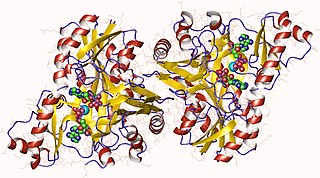
Acetyl-CoA carboxylase (ACC) is a biotin-dependent enzyme that catalyzes the irreversible carboxylation of acetyl-CoA to produce malonyl-CoA through its two catalytic activities, biotin carboxylase (BC) and carboxyltransferase (CT). ACC is a multi-subunit enzyme in most prokaryotes and in the chloroplasts of most plants and algae, whereas it is a large, multi-domain enzyme in the cytoplasm of most eukaryotes. The most important function of ACC is to provide the malonyl-CoA substrate for the biosynthesis of fatty acids. The activity of ACC can be controlled at the transcriptional level as well as by small molecule modulators and covalent modification. The human genome contains the genes for two different ACCs—ACACA and ACACB.

Malonyl-CoA is a coenzyme A derivative of malonic acid.

Oxaloacetate decarboxylase is a carboxy-lyase involved in the conversion of oxaloacetate into pyruvate.

Malonyl-CoA decarboxylase, is found in bacteria and humans and has important roles in regulating fatty acid metabolism and food intake, and it is an attractive target for drug discovery. It is an enzyme associated with Malonyl-CoA decarboxylase deficiency. In humans, it is encoded by the MLYCD gene.

In molecular biology, Beta-ketoacyl-ACP synthase EC 2.3.1.41, is an enzyme involved in fatty acid synthesis. It typically uses malonyl-CoA as a carbon source to elongate ACP-bound acyl species, resulting in the formation of ACP-bound β-ketoacyl species such as acetoacetyl-ACP.

In enzymology, a biotin carboxylase (EC 6.3.4.14) is an enzyme that catalyzes the chemical reaction
In enzymology, a [acyl-carrier-protein] S-acetyltransferase is an enzyme that catalyzes the reversible chemical reaction
In enzymology, a [acyl-carrier-protein] S-malonyltransferase is an enzyme that catalyzes the chemical reaction

Fatty-acyl-CoA Synthase, or more commonly known as yeast fatty acid synthase, is an enzyme complex responsible for fatty acid biosynthesis, and is of Type I Fatty Acid Synthesis (FAS). Yeast fatty acid synthase plays a pivotal role in fatty acid synthesis. It is a 2.6 MDa barrel shaped complex and is composed of two, unique multi-functional subunits: alpha and beta. Together, the alpha and beta units are arranged in an α6β6 structure. The catalytic activities of this enzyme complex involves a coordination system of enzymatic reactions between the alpha and beta subunits. The enzyme complex therefore consists of six functional centers for fatty acid synthesis.
Rhizobium leguminosarum is a bacterium which lives in a mutualistic symbiotic relationship with legumes, and has the ability to fix free nitrogen from the air. R. leguminosarum has been very thoroughly studied—it has been the subject of more than a thousand publications.
Malonyl-S-ACP:biotin-protein carboxyltransferase is an enzyme with systematic name malonyl-(acyl-carrier protein):biotinyl-(protein) carboxytransferase. This enzyme catalyses the following chemical reaction
Acetyl-S-ACP:malonate ACP transferase is an enzyme with systematic name acetyl-(acyl-carrier-protein):malonate S-(acyl-carrier-protein)transferase. This enzyme catalyses the following chemical reaction
Malonate decarboxylase holo-(acyl-carrier protein) synthase is an enzyme with systematic name 2'-(5-triphosphoribosyl)-3'-dephospho-CoA:apo-malonate-decarboxylase 2'-(5-phosphoribosyl)-3'-dephospho-CoA-transferase . This enzyme catalyses the following chemical reaction
Biotin-independent malonate decarboxylase (EC 4.1.1.88, malonate decarboxylase (without biotin), malonate decarboxylase, MDC) is an enzyme with systematic name malonate carboxy-lyase (biotin-independent). This enzyme catalyses the following chemical reaction
Biotin-dependent malonate decarboxylase (EC 4.1.1.89, malonate decarboxylase (with biotin), malonate decarboxylase) is an enzyme with systematic name malonate carboxy-lyase (biotin-dependent). This enzyme catalyses the following chemical reaction
Carboxybiotin decarboxylase (EC 7.2.4.1, MadB, carboxybiotin protein decarboxylase) is an enzyme with systematic name carboxybiotinyl-(protein) carboxy-lyase. This enzyme catalyses the following chemical reaction
Acetate—[acyl-carrier protein] ligase is an enzyme with systematic name acetate:(acyl-carrier-protein) ligase (AMP-forming). This enzyme catalyses the following chemical reaction

Ketoacyl synthases (KSs) catalyze the condensation reaction of acyl-CoA or acyl-acyl ACP with malonyl-CoA to form 3-ketoacyl-CoA or with malonyl-ACP to form 3-ketoacyl-ACP. This reaction is a key step in the fatty acid synthesis cycle, as the resulting acyl chain is two carbon atoms longer than before. KSs exist as individual enzymes, as they do in type II fatty acid synthesis and type II polyketide synthesis, or as domains in large multidomain enzymes, such as type I fatty acid synthases (FASs) and polyketide synthases (PKSs). KSs are divided into five families: KS1, KS2, KS3, KS4, and KS5.
The Malonate:Na+ Symporter (MSS) Family (TC# 2.A.70) is a group of transport proteins belonging to the CPA superfamily. These proteins are composites with constituents ranging in size from 129 to 255 amino acyl residues (aas) and exhibiting 4 to 7 transmembrane segments (TMSs). A representative list of proteins belonging to the MSS family can be found in the Transporter Classification Database.
The Na+-transporting Carboxylic Acid Decarboxylase (NaT-DC) Family (TC# 3.B.1) is a family of porters that belong to the CPA superfamily. Members of this family have been characterized in both Gram-positive and Gram-negative bacteria. A representative list of proteins belonging to the NaT-DC family can be found in the Transporter Classification Database.








